
|   |

|   |
The Gunjan Dance and Music Festival - Manjari Sinha e-mail: manjari@sinha.com Photos courtesy: Gunjan January 7, 2020 The 23rd edition of Gunjan Dance and Music Festival (22-24 November) was organized at the Shaheed Bhawan auditorium, Cuttack, by Gunjan Dance Academy, established by the celebrated Odissi exponent Meera Das in 1996. The most awaited annual event of this culturally vibrant city of Odisha, this multihued festival offers not just music and dance performances by some of the best established and upcoming artists but showcases visual and creative arts exhibitions as well. On this occasion, the institution honours some senior scholar/artiste with Nibedita Pattnayak Samman for their lifetime contribution to the field of Arts. Musician/composer Dr Prafull Kar was the recipient of the award this year, for his valuable contribution to Odissi music. 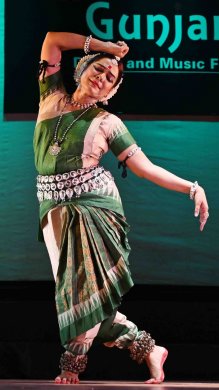 Meera Das Meera Das gave a befitting start to the performances following the award ceremony on the concluding evening of the three day festival. Her moving abhinaya impersonating Ram bhakt Hanuman titled 'Shri Rama Preyashi' on the Odia song "Mo Shri Rama kinkar", opened with the Sanskrit shloka 'Shri Rama sharanam prapadye' rendered soulfully in raga Chandrakauns. Meera depicted the deep devotional emotions of Hanuman towards Sri Rama through the Ashok Vatika Prasang, where Hanuman spots Seeta, convinces her of his credibility as an ardent devotee of Rama, "Biswas laabhi me tumara...", by offering her his ring and brings back her message for Rama along with her chudamani, the hair jewel. The whole choreography was imaginatively conceived and designed in Hanuman-centric mudras and movements with a sprinkling of humour that had both the delicate grace of Odissi lasya and the power of tandava too, in lifting and flying with the mountain to bring Sanjeevani herbs for injured Lakshman. 'Bindu ru Sindhu' (from a drop to the ocean), the annual production of Gunjan Dance Academy for this festival, was the latest feather in the cap of its choreographer Meera Das. The group choreography depicted the story of a drop, that could be the inception of any endeavour; surging into a cascading waterfall, turning into a stream merging into a river and finally reaching its infinite destination, the ocean. One could discern in the well-synchronized dance the swirls and waves sometimes serene, at times disastrous, yet becoming generous, symbolising the predicaments of life itself. Thoughtfully composed musical score by the gifted flautist and composer Annada Prasanna Pattanaik could bring out the desired effect in each and every scene of the captivating choreography, through the use of different ragas and talas to match the journey of Bindu, even contemporary music to depict the vastness of the enormous ocean, the Sindhu. The aesthetics of costumes, clean technique and fluidity in isolated torso movements vouched for the perfect grooming of the Gunjan repertory under Meera Das, who refrained from dancing herself to watch the end result of this fantastic production, that must have elevated her sense of satisfaction and pride in her creative endeavours. 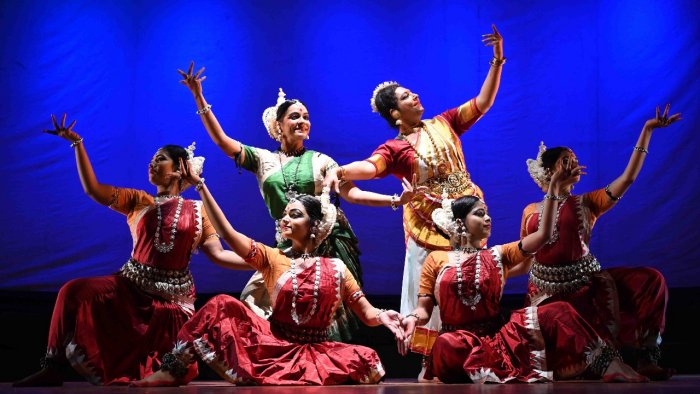 Odissi and Mohiniattam duet by Meera Das and Mom Ganguly The Gunjan Fitness Studio presented a Yoga based dance number opening with "Shambho Shiva Shambho....", before the evening concluded with an Odissi and Mohiniattam duet by Meera Das and Mom Ganguly, joined later by four of their disciples concluding with "Sangachhadhwam, sam-vadaddhwam, samvomanaansi jaanataam...." merging into a fantastic freeze. The three-day festival had opened with Jagannath Mangalam that brought alive vivid scenes of the auspicious Rath-Yatra of Jagannathpuri, where the holy procession was led by the dancers playing musical instruments and dancing with devotional fervour, while the chariot of the Lord adorned with the chhatra like halo, was pulled diagonally through the stage by another set of dancers. The well-groomed dancers of the academy also presented Batu and Shankarabharana Pallavi before reaching the inaugural evening to its climax with the dance-drama 'Krishna Kathamruta', presenting vignettes of Krishna Leelas from Makhan-chori, Bakasura-Vadha to Maharasa in the clouds of Abir-Gulal on Holi, the festival of colours. 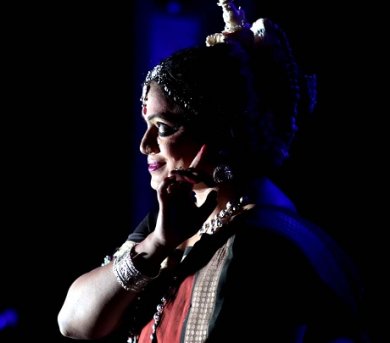 Sonali Mohapatra The guest artist of the evening Sonali Mohapatra, disciple of Guru Durga Charan Ranbir, mesmerised the audience with her moving abhinaya for the ashtapadi, 'Kuru Yadunandana', composed by Abhiram Nanda in raga Pilu, where his melodious flute also created magical spell augmenting the emotional aura. The second evening of the festival represented the music segment with a sitar recital by Ravishankar Pradhan and troupe comprising Pradipt Shekhar Mohapatra on flute, Suraj Kumar Rath on octapad, Sukant Kumar on tabla and Jagannath Das Mohanty on keyboards. Announced as fusion of Indian and Western music, the composition was based on raga Hamsadhwani opening with an Aalap, proceeding to the bandish set to teentaal where all of them took turns, culminating into a session between the tabla and octapad. The sitarist Ravishankar Pradhan was initiated into music by his father and was further groomed under Pt. Bimalendu Mukherjee, hence his sitar had the authentic fragrance of the Imdadkhani Etawah Gharana. The Odissi Abhinaya by Bidya Biswajeeta on Tulasidas pada "Shri Ramchandra Kripalu bhajamana..." depicted the whole of Rama Katha during the introductory Aalap only. There were sancharis like Seeta Swayamvara during "Naumi Janaka suta varam" very thoughtfully woven into the choreography. The Sabhinaya Pallavi on raga Basant by the Gunjan Dance Troupe made for a good preface to "Lalita lavanga lata..." ashtapadi in group choreography by Priyanka Jena. Mohiniattam by Mom Ganguly and troupe was good as a dance performance but the music had nothing to do with the dance form, opening with a Hindi song "Dhan dhan Krishna Murari, koi kahat tumhe Krishna Kanhaiya..." sounding like a Chhota khayal in raga Bhupali with no flavour of this classical dance form from Kerala. Although the Kanduka Kreeda belonged to the Mohiniattam repertoire, tabla again sounded intruding into the authentic musical instruments like chenda. Pandattam in raga Pantuvarali sounded more convincing as a Mohiniattam performance. 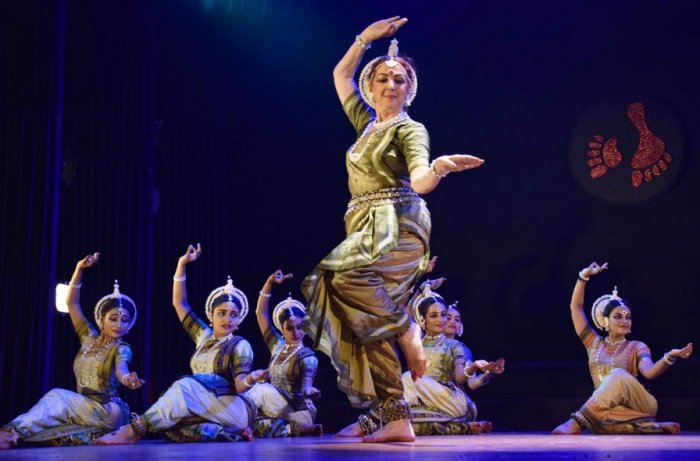 Ileana Citaristi and Art Vision troupe The senior exponent of Odissi, Ileana Citaristi and her Art Vision troupe opened with a Pallavi like choreography based on raga Bhupali/Mohanam. This was followed by 'Ganga-Jamuna', a thematic Odissi dance work conceived, created and choreographed by Ileana Citaristi with music by Pt. Gopal Panda. "Lasyaang raga vibhati Ganga, Bhinna prawaha Yamuna tarange..." based on raga Chandrakauns effectively depicted the contrasting temperament and gaits of both the rivers. The group choreography of Ileana Citaristi deserved better dancers but she uplifted the dance work by joining them towards the end. 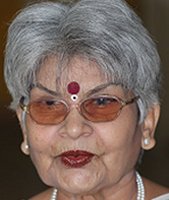 Manjari Sinha has an M.A. in Sanskrit and Music, and trained in vocal, tabla, sitar and Kathak dance. She has regular columns in national dailies as a music and dance critic. |